
On the 6th January, 1969, the electrified line between Polegate to Stone Cross Junction closed. This resulting in all trains to and from London and Brighton having to go via Eastbourne to reverse to carry on to Hastings & Ore
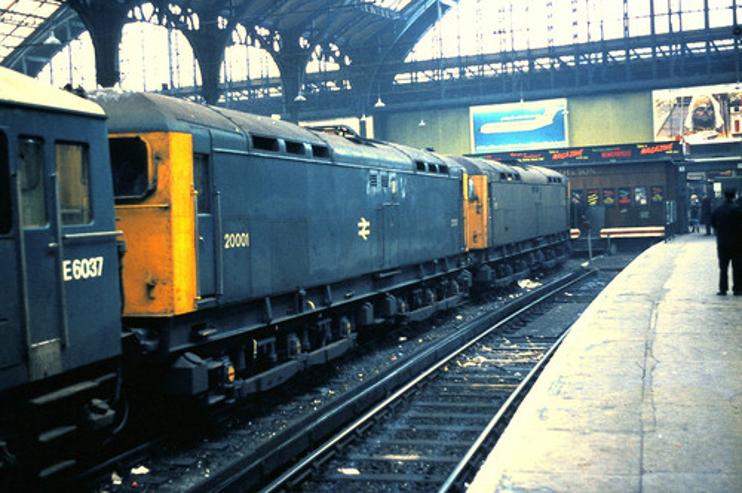
ANDY GIBBS COLLECTION
Brighton Middle Road 25th January 1969
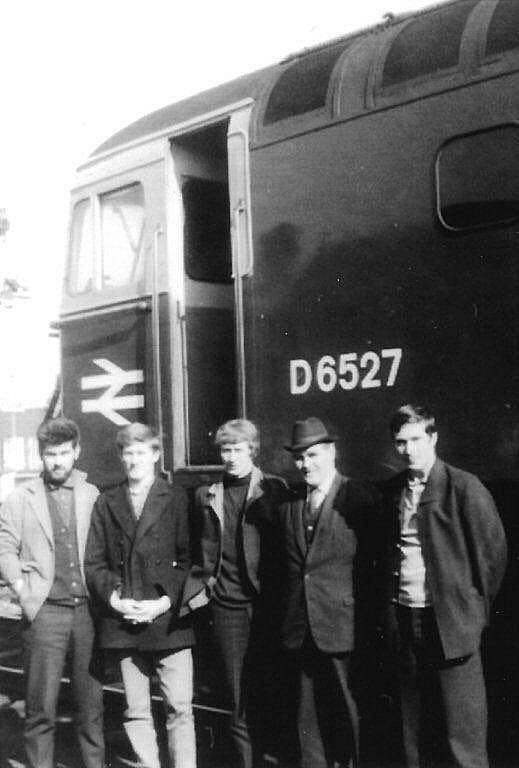
RAY COOPER COLLECTION
Class 33 training January 1969
Left to right, Dave Strudwick Norwood, Ray Cooper Hither Green, Biff Manvell Three Bridges/Redhill, Ted “the Colonel" Lynch (Instructor) & Graham Pink Eastleigh.
On the 22nd February, 1969, the electrified line between Polegate to Stone Cross Junction closed. This resulting in all trains to and from Brighton having to go via Eastbourne.
LEWES TO UCKFIELD LINE
THE WITHERED ARM OF SUSSEX
Extracted and adapted from the
Brighton Main Line Website
On 23rd February 1969, British Rail closed a 9-mile section of its second main line between
London and Brighton to enable a new road to be built across it. This seemingly innocuous
decision was an action BR came to bitterly regret, whilst all subsequent attempts to reopen
the route in the ensuing decades have failed. For Sussex, Kent and Surrey it has proven to be
a disaster, whilst the economic, social and environmental consequences are still being
suffered today.
It wasn’t meant to be like this as, only a decade earlier, plans to modernise and electrify this
important route were announced in the spring of 1957 at a Special Press Conference in
Brighton by the General Manager of British Railways Southern Region. The Sussex Express
reported ‘New Electrification Schemes to Benefit Sussex Areas: After the completion of
their first priority – the Kent Coast electrification scheme – due in 1961, British Railways
intend to electrify the Oxted Line to give a regular service of through trains between London,
Tunbridge Wells West, East Grinstead and Brighton via Uckfield.’
At a meeting of local councils in September 1958 BR’s Traffic Superintendent announced
work on modernisation had already started, whilst electrification would commence in 1962.
He spoke of the sharp increase in passenger traffic since the introduction of new interval
train services offering greater frequency.
So why was this major electrification scheme halted and why were profitable routes with
such a bright future closed?
Unfortunately in 1959 Ernest Marples was appointed Transport Minister, a politician who
fervently favoured roads and eventually became notorious for his pecuniary interest in
building them. The timing could not have been worse because Marples was sympathetic to
the ‘Lewes Inner Relief Road’ and approved an incredibly controversial plan promoted by
East Sussex County Council to build a dual carriageway through Lewes town centre. This
£350,000 scheme was allotted a Government grant of 75% making it irresistible to ESCC.
However, Lewes Town Council, the Friends of Lewes and the townsfolk mounted a
tremendous fight against the proposal and its devastating swathe through the historic County
Town of East Sussex.
Tragically the Uckfield line stood directly in the path of the road’s first phase; however,
British Railways had no plans to close the line as it was scheduled for electrification and
development. The County Council opposed bridging the line, apparently on grounds of
‘design and amenity’ so British Rail sought a compromise, securing an Act of Parliament
during 1965 to re-open an alternative route into Lewes along the original Hamsey spur. This
would enable that portion of railway line in conflict with the new road scheme to be closed.
The downside was that southbound trains entering Lewes from London and from Tonbridge
would face towards Eastbourne instead of Brighton as before, but at least this would retain
the very important London – South Coast link.
Train services would recommence by the summer of 1967 over the new Hamsey link which
would cost £95,000 to reconstruct; however, BR’s application for funding to the recently-
elected Labour Government was refused.
With its primary function at risk, BR saw no future for a line terminating in the middle of
East Sussex at Uckfield and retaliated by applying to close all the lines being made ready for
electrification; including stations at Barcombe Mills, Isfield, Uckfield, Buxted,
Crowborough, Eridge, Ashurst, Cowden, Hever, Edenbridge Town, Groombridge, and
Tunbridge Wells West. Protests were widespread with residents from towns and villages
converging on Tunbridge Wells to demonstrate.
The battle to save the route involved not only MPs, but also the House of Lords who warned
of the utter folly because of the Brighton Line’s notorious vulnerability. Relying on just one
very heavily-loaded line between London and Brighton would be ill-advised. Transport
Minister Barbara Castle would not be swayed, despite evidence that the trains were well-
used between Uckfield and Brighton and ironically it was the busiest section.
Pressure was exerted, whereby in an effort to deter patronage, BR withdrew most through
services, necessitating a change of trains at Lewes. To make matters even worse British Rail
went on to declare that the iron viaduct carrying the line into Lewes had suddenly become
‘unsafe’ and would require ‘major expenditure’. They insisted it could only be used by a 2-
car shuttle train operating between Lewes and Barcombe Mills – the next station towards
Uckfield – where passengers then had to change trains towards London. Locals pointed out
that the viaduct was perfectly fine for Her Majesty’s Royal Train only a few months earlier.
Richard Marsh, who succeeded Barbara Castle in 1968, made a prompt decision in
consenting to the closure of the Lewes–Uckfield section, whereupon Sussex’s ‘withered arm’
would have to rely on a public subsidy. The last trains ran on 23rd February 1969, enabling
the victorious road-builders’ bulldozers to finally break through and complete the first phase
of the new Relief Road. To cap it all, the hugely contentious stages 2 and 3, involving a deep
cutting and dual carriageway through Lewes town were abandoned that autumn. Sussex,
Kent and Surrey lost a strategic rail connection and continue to reap the consequences to this
day.
For its part, Lewes gained a very large flyover across the River Ouse and a road to nowhere.
The outcome has not been limited to just the lack of train services between Lewes and
Uckfield. On that same day in 1969, all main line services between Tunbridge Wells West
and London Victoria were withdrawn, leaving only a local shuttle connection between Eridge
and Tonbridge. This too was subsequently removed in 1985, whilst the Uckfield line
declined further during the 1980s and was eventually partially-singled.
Richard Marsh left government when Wilson was defeated in 1971 and became the
Chairman of the British Railways Board where he stayed until 1976 when he was knighted,
becoming Baron Marsh in 1981 after joining the Conservatives in 1978.
Asked in 2003 whether he had any regrets over his decision, he responded: “Unfortunately I
held the post of Minister of Transport for only a few months between 1968 and 69, by far the
shortest period of any post I have held since I started work 61 years ago! I would be
surprised if the Uckfield-Lewis [sic] closure had not taken place earlier but after 33 years I
am afraid I really have no reliable recollection of the events of those few months.”
The myth that this was merely a Beeching closure because it didn’t pay endures to this day,
but nothing could be further from the truth, whilst the events of half a century ago were not
confined to a corner of seemingly rural Sussex.
It remains one of the most contentious closures anywhere in the UK because railways, by
their very nature, connect us together and engender prosperity, business and well-being for
the communities many miles apart. This single action resulted in the loss of two main line
routes – between London and Brighton/Lewes and between London and Tunbridge Wells
(West). Both routes are desperately needed and unquestionably this need can only increase in
the years ahead.
With the closure of this section line which had a major impacted to the work allocated
mainly at Brighton Mixed Traction andTunbridge Wells West. Other depots was also effected
by the closure of this vital route to the London termini and Tonbridge. At Brighton Mixed
Traction it caused manning issues at these. Brighton Mixed Traction still retained worked
down the Oxted line to Uckfield, Tunbridge Wells West & East Grinstead.
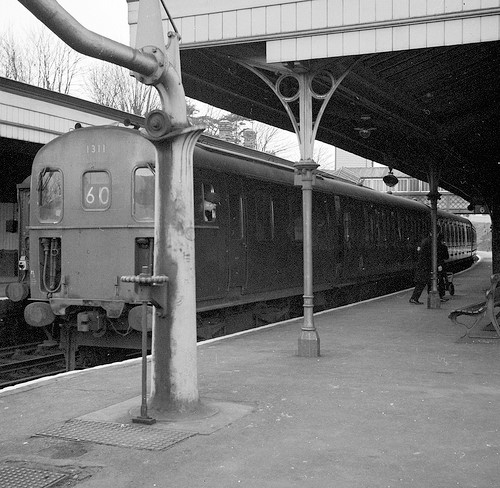
PHOTOGRAPHER UNKNOWN
A Brighton to Tunbridge Wells West service at Lewes
Railway accident on British Railways
Southern Region
Central Division
CRYSTAL PALACE MOTORMEN'S DEPOT
OPENED 25th MAY 1911 - CLOSED c1969
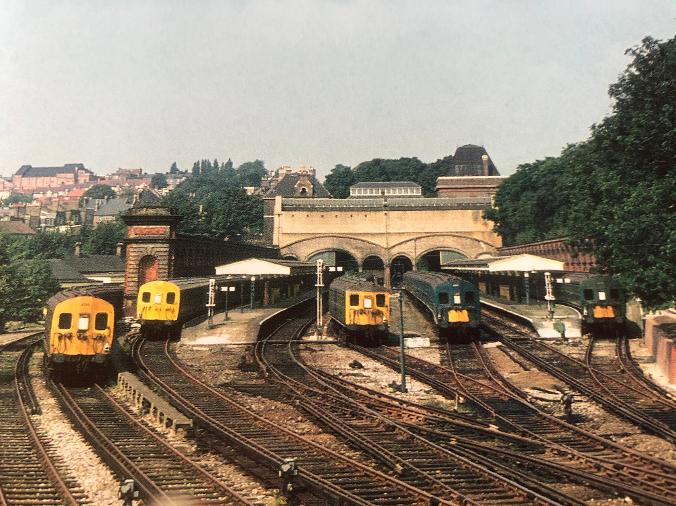
PHOTOGRAPHER UNKNOWN
Crystal Palace Station looking towards Tulse Hill.
This photo was taken when the depot was open and showing the various trains berthed there.
EPSOM DOWNS MOTORMEN'S DEPOT
OPENED 17th JUNE 1928 - CLOSED 1969
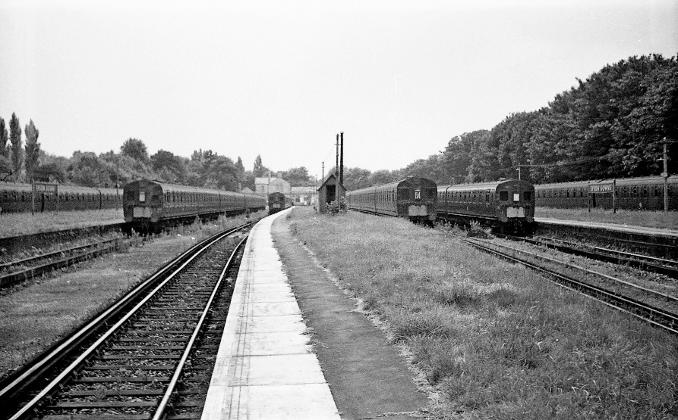
PUT - BACK DRIVER OF A RESTRICTED DRIVER
AT BRIGHTON M.T.
The members of Brighton No.1 Branch of A.S.L.E.F., (Mixed Traction Depot) needed to seek clarification of a driver who was to become a stand "Put-Back" Driver, but there appeared to be some confusion as to his entitlement. The position is an explanation of his position.
Driver Joe Gray was involved in an accident whilst off duty in which he lost his right leg from above the knee joint. Owning to a similar accident involving a Redhill driver some time ago, the Medical Officer deemed that all men with artificial legs were not allowed to work traction with foot operated safety devices. In view of this Driver Joe Gray was given along with another Brighton Driver of similar disability a regular turn of duty on D.E.M.U.s. Upon the closure of the line from Uckfield to Lewes, all the D.E.M.U. duties work was withdrawn from Brighton Mixed Traction, and later a small number of D.E.M.U. duties were re-allocated, but none could be spared for these restricted men at Brighton. This coincided with the closure of Three Bridges Mixed Traction, Eastbourne Mixed Traction and Feltham depot. The other restricted man had an 8(b) (a pereference) move registered for West Worthing E.M.U.T. and was fortunate to get his job there. However Driver Gray was unable to fulfil his duties at Brighton owning to the traction restriction and was offered a job at Tunbridge Wells. This he declined owning to the travel difficulties involved i.e. the line closure. He therefore indicated that he was willing to stand “Put-Back” at Brighton in the hope that further D.E.M.U. duties would be allocated, or wait for rationalisation to take place at Brighton. The management will not say he is redundant, and we cannot establish his true position. The Brighton No.1 Branch felt that their member was a candidate for the application of clause 19 of the P.T. & R., but apparently Sectional Council "B" did not. Driver Gray was still classified as a driver, and his pay bill, but he was only receiving 340/-. Driver Gray was “Put-Back” with the introduction of the new service timetable which came into operation on July 1st, 1969.
It was point out to the General Secretary, that Driver Gray was not the "Junior Driver" at the depot, and according to ASLEF's circular 59, The Brighton No.1 Branch felt that he is entitled to be paid 379/-. Would you kindly clarify this man’s position for the Branch, and perhaps explain why Clause 10 was not applied in his case.
Drivers already standing “Put - Back"
With effect from August 25th, 1969, a Driver who standing “Put - Back” at his own depot rather than transfer to another depot will be paid 10/- less than the Driver’s rate of pay, i.e. 369/- on present rates of pay.
Drivers “Put - Back” before the 25th August, 1969 and have elected to remain at their own depots shall be paid at 379/- per week on a personal basis. This rate will be effective from 12th August 1968.
John Vaughn Collection
KEMPTOWN JUNCTION
APPROPRIATE RATE TO BE APPLIED TO
A DRIVER - PUT - BACK
AS A RESULT OF REDUNDANCY
The Brighton No.1 Branch received correspondence back from ASLEF Head Office in connection with the above subject. Head Office have raised this matter with Sectional Council No.2 Southern Region, and set out below copy of the reply received from the Staff Side Secretary:-
“The fact as to the position of Driver Gray are as follows are as the Branch Secretary relates them in-so-much as he was declared redundant, though not the Junior Driver, because the L.D.C. informed us that there would not be no work available at the Depot because of Gray’s disability, we tried to accommodate him at a Depot with the type of work consistant with Medical Officers ruling but as you were informed Gray declined this. We were of the opinion that the only course left open to us was to stand Gray “Put-Back” at Brighton M.T. Depot hoping that when rationalisation plans for the Area were complete we could then accommodate him on E.M.U.T. work at the proposed Brighton Depot.
To accommodate Gray under Clause 10 in the Brighton Area leads to problems of P.T.R. nature, there being registration for all Depots in the coastal area under either Clause 14 (a) or 8 (b) which as you are aware are prior Claused according to Clause 7. If Gray feels he would like to be reinstated as a Driver and have Clause 10 apply I feel that it may possible to find a position for but not in the Brighton area.”
In conclusion I must say that Gray was created redundant because of loss work and according to the amplified arrangements he chose to stand “Put-Back” rather than move because there were no vacancies within a reasonable distance and of course there was a chance to stand “Put-Back” at his own Depot.
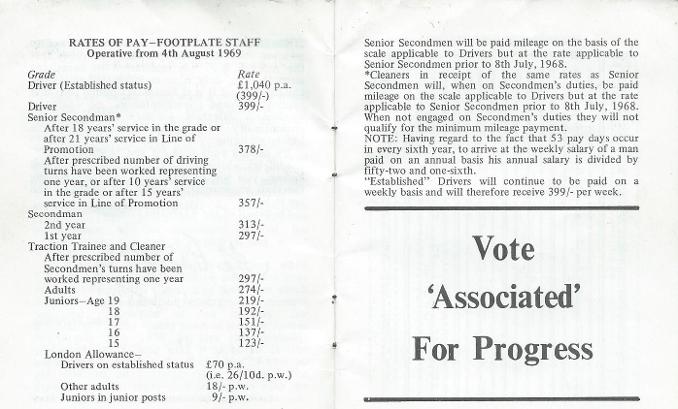
Extracted and adapted from
Tunbridge Wells Branch Meeting
Sunday October 12th 1969 at 10.30 p.m.
at the Welfare Rooms, Central Station
L.D.C. Report Bro. A. Brooker outlined the so called Final Statement of Intent.
This paper is of little alteration from the preliminary statement. The meeting held at Redhill on Thursday October 9th 1969 and attended by L.D.C.s from Redhill M.T. & E.M.U.T. Tattenham Corner, Dorking (C), T. W . W. rejected unanimously the present form of the statement as still un-informative and asking for Secretary Council No.2 and higher management to meet L.D.C.s.
The meeting closed at 12.45
Members present Bros. Bro. V. Rumley, D. Ward W. Baldwin, R. Bridger, H. Love, R. Brown, A. Brooker & F. Diplock.
LOCOMOTIVE JOURNAL
NOVEMBER 1969
E.C. VICE PRESIDENT BILL RONKSLEY WRITES ON
THE TRAINMEN’S CONCEPT
The Trainmen’s Concept was the subject of discussions during Stage 1 and Stage of the Pay
and Efficiency Negotiations. In this article I will explain what was proposed by the B.R.B.
and why agreement was not possible.
THE PROPOSALS
The B.R.B. proposed the merging of the existing grades of Secondmen and Guards and the
introduction of a new grade of Trainman. It was the intention of the Board that Trainmen
would perform the combined duties of Secondmen and Guards and be in the Line of
Promotion to Driver.
In their proposals the Board suggested that existing Secondmen would retain their date of
entry into the Line of Promotion as their seniority date for promotion to the grade of Driver
and for determining their link position when in links composed of duties which were
previously those of Secondmen. When undertaking duties which were previously those of
Guards it was proposed that whilst existing Secondmen would retain their original seniority
date for promotion to Driver their seniority date for link working purposes would be the date
of transfer to Guard’s duties.
The Board proposed that existing Guards under the age of 40 years, subject to suitability,
would be given the opportunity to transfer to the Driver’s Line of Promotion. Guards
transferring under the aforementioned arrangement would have retained their existing
relative seniority date for redundancy in competition with other Guards and for link working
purposes in links composed of duties previously those of Guard. It was also proposed that the
seniority date for promotion to the Grade of Driver of existing Guards opting to enter the
Line of Promotion to Driver would be the date of the introduction of the new grade of
Trainman.
Under the proposals Guard over the age of 40 years and those under the age of 40 years
either unwilling or unsuitable to transfer to the Driver’s Line of Promotion would have
retained their right to seek promotion through their existing channels.
On the introduction of the new grades existing Secondmen and Guards would have retained
their present link arrangements but this arrangement would not have precluded the Trainmen
who were previously Guards being called upon to perform existing Secondmen’s duties and
Trainmen who were previously Secondmen performing existing Guard’s duties as occasion
demanded.
In cases where economy would have accrued it was proposed that two former grades of
Secondman and Guard may be merged and the spare Secondmen and Guards placed in a
common link or utilised on any duties covered by former grades.
Surplus Secondmen (redesignated as Trainmen) may have been called upon to fill vacancies
in the existing grade of Guard at their own or neighbouring depots on the understanding that
their position in regard to the protection of earnings was safeguarded.
The Board proposed that as vacancies arise the introduction of the grade of Trainman the
appropriate job should be placed in a new link or links which may have been a mixture of
former Secondmen’s or Guard’s work placed above or below the “Spare” link as agreed
locally. It was further proposed that the seniority date for determining the position in the
“Mixed” link should be the date of entry into the link. Vacancies arising by secessions from
the grade after the date of the agreement were, under the proposals, to be used in the first
place to accommodate surplus staff at the depot and then to be available to staff in the grade
at the depot who may have been desirous of transferring to the “New” integrated link. It was
then proposed that vacancies remaining after the operation of the procedure outlined above
should be advertised to the section of staff which would have been eligible to apply for the
original vacancy (Secondman or Guard) under the arrangements in the operation prior to the
creation of the new grade, with the proviso that staff over 40 years of age not in the Driver’s
Line of Promotion would be ineligibe.
The Board proposed that in the event of redundancy arising the staff should be dealt with
under the redundancy arrangements applicable to their former grades.
In their proposals the Board have proposed that the rates of pay of Senior Secondmen should
be extended to all Trainmen after 10 years’ service in the grade or after 15 years’ service in
the Line of Promotion and after 18 years’ service in the grade or 21 years’ service in the Line of Promotion.
THE TRADE UNIONS AND THE TRAINMEN’S CONCEPT
The N.U.R. has indicated that there is no basis of agreement on the proposals of the B.R.B
during the P. & E. negotiations the N.U.R. negotiations intimated that in their opinion Guards
becoming Trainmen should be credited with certain amount of seniority in the Line of
Promotion to Driver. Our Society was unable to agree to this.
A.S.L.E.&F. is of the opinion that the proposals of the Board are a basis for negotiations. Of
course, this does not mean that the Society is prepared to agree to the whole of the proposals
of the Board.
In my opinion agreement on the Trainmen’s Concept would have:
1, Ensured the manning of the trains of the future by skilled craftsmen who would have
progressed from Traction Trainee to Trainmen and then from Trainman to Driver.
2, Enabled the B.R.B. to man train sensibly thereby avoiding unnecessary cancellations of
trains.
3, Enabled the Trade Unions to negotiate higher rates of pay than those obtained in P.&E.
It is important to note that, even on the rates of pay negotiated in the P.&E. (Stage 2), had the
Trainmen’s Concept been agreed some Guards on becoming Trainmen would have qualified
for the rates of pay of Senior Secondman, meaning that they would have had rates of pay
357/-, or 378/-, instead of 313/-. The Board has also hinted that they would be prepared to
consider the extension of Senior Secondmen’s rates of pay to Guard who are too old (over 40
years) to become Trainmen in the Line of Promotion to Driver.
THE FUTURE
The Executive Committee of our Society has examined the position arising from the failure to
obtain agreement on the Trainmen’s Concept and has requested the B.R.B. for an early
meeting to discuss and make agreement on the future requirement and training of Footplate
Staff.
Our member may rest assured that the Executive Committee are to give this matter their
urgent attention.
Railway accident on British Railways
Southern Region
Central Division